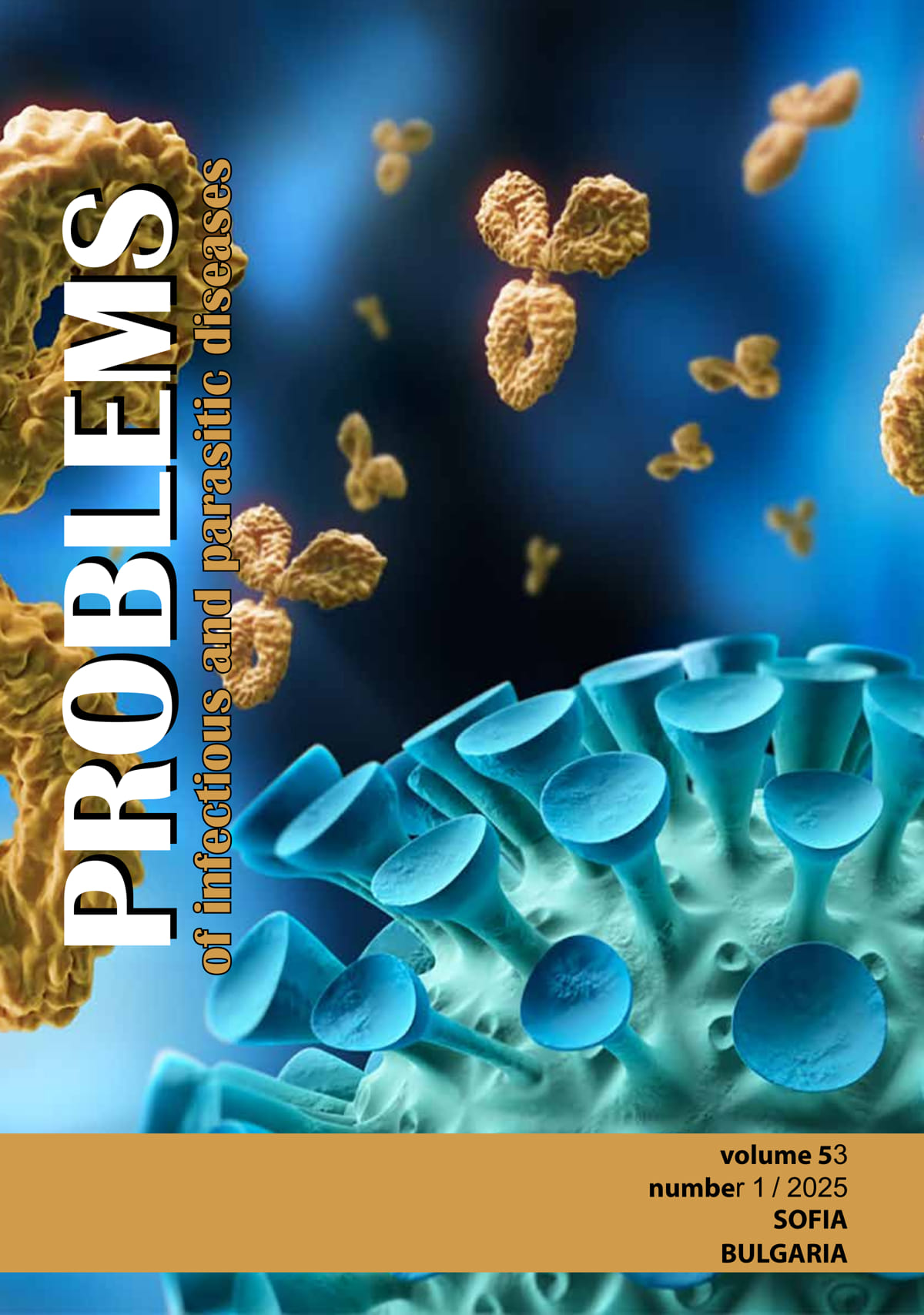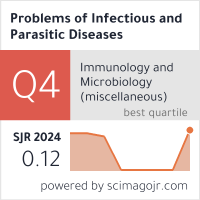IDENTIFICATION OF MYCOBACTERIUM TUBERCULOSIS COMPLEX SPECIES IN BULGARIA
DOI:
https://doi.org/10.58395/ee9mve71Keywords:
M. tuberculosis, M.bovis, M.capraeAbstract
Tuberculosis is caused by closely related mycobacterial species, designated as M.tuberculosis complex (MTBC), which includes : M.tuberculosis sensu stricto, M.africanum, M.canettii, M.bovis, M.caprae, M. microti. There is an increase in human TB cases caused by M.bovis or M.caprae in the EU. Although Bulgaria is not a bovine TB-free country, the species identification inside the MTBC is not routinely performed for human isolates and the presumably animal related pathogens could not be distinguished. This study aimed to reveal the presence of M.bovis/M.caprae as an aetiological agent on the territory of Bulgaria.
For the period from 2022 to 2025, a total of 175 MTBC strains were further examined to differentiate the species. GenoType MTBC VER 1.X was used as a reliable identification tool.
Almost all cases were found to be M.tuberculosis/M.canettii (n=173; 98.85%). The prevalence of Mycobacterium bovis was 0.57%. M.bovis BCG also was represented by a single isolate (0.57%). M.africanum, M.microti, or M.caprae have not been detected so far.
Species identification in the MTBC is an essential step in order to limit the transmission from animal to human and to refine the treatment of the affected individuals.
Downloads
References
1. https://www.who.int/campaigns/world-tb-day/2024
2. Brites D, Gagneux S. Co-evolution of Mycobacterium tuberculosis and Homo sapiens. //Immunological Reviews, 2015, 264(1), p. 6-24. https://doi.org/10.1111/imr.12264
3. Reis, A.C., Cunha, M.V. Genome-wide estimation of recombination, mutation and positive selection enlightens diversification drivers of Mycobacterium bovis. Sci Rep 11, 18789 (2021). https://doi.org/10.1038/s41598-021-98226-y
4. Brites D, Loiseau C, Menardo F, Borrell S, Boniotti MB, Warren R, Dippenaar A, Parsons SDC, Beisel C, Behr MA, Fyfe JA, Coscolla M, Gagneux S. A New Phylogenetic Framework for the Animal-Adapted Mycobacterium tuberculosis Complex. Front Microbiol. 2018 Nov 27;9:2820. https://doi.org/10.3389/fmicb.2018.02820. PMID: 30538680; PMCID: PMC6277475.
5. Alexander KA, Laver PN, Michel AL, et al. Novel Mycobacterium tuberculosis complex pathogen, M. mungi. Emerg Infect Dis. 2010 Aug http://dx.doi.org/10.3201/eid1608.100314.6
6. Emmanuel FX, Seagar A-L, Doig C, et al. Human and animal infections with Mycobacterium microti, Scotland.//Emerg Infect Dis, 2007. https://doi.org/10.3201/eid1312.061536
7. Macedo R, Isidro J, Gomes MC, et al. Animal-to-human transmission of Mycobacterium pinnipedii. Eur Respir J 2020. https://doi.org/10.1183/13993003.00371-2020
8. Mentula S, Karkamo V, Skrzypczak T, Seppänen J, Hyyryläinen HL, Haanperä M, Soini H. Emerging source of infection - Mycobacterium tuberculosis in rescue dogs: a case report. Access Microbiol. 2020 Sep 7;2(11):acmi000168. https://doi.org/10.1099/acmi.0.000168 PMID: 33294771; PMCID: PMC7717481.
9. van Ingen J, Rahim Z, Mulder A, Boeree MJ, Simeone R, Brosch R, et al. Characterization of Mycobacterium orygis as M. tuberculosis complex subspecies. Emerg Infect Dis [serial on the Internet]. 2012 Apr [date cited]. http://dx.doi.org/10.3201/eid1804.110888
10. de Jong BC, Antonio M, Gagneux S. Mycobacterium africanum-review of an important cause of human tuberculosis in West Africa. PLoS Negl Trop Dis. 2010 Sep 28;4(9):e744. https://doi.org/10.1371/journal.pntd.0000744 PMID: 20927191; PMCID: PMC2946903.
11. Comín J, Monforte ML, Samper S, Aragonese Working Group on Molecular Epidemiology of Tuberculosis (EPIMOLA), Otal I. Analysis of Mycobacterium africanum in the last 17 years in Aragon identifies a specific location of IS6110 in Lineage 6. Sci Rep. 2021 May 14;11(1):10359. https://doi.org/10.1038/s41598-021-89511-x PMID: 33990628; PMCID: PMC8121931.
12. Mencarini J, Veloci S, Simonetti MT, Carocci A, Meli M, Tortoli E, et al. Two cases of sternal osteomyelitis due to Mycobacterium africanum: a casual or causal association. International Journal of Mycobacteriology, Volume 5, Issue 3, 2016, Pages 354-356, ISSN 2212-5531, https://doi.org/10.1016/j.ijmyco.2016.05.006
13. O'Reilly LM, Daborn CJ. The epidemiology of Mycobacterium bovis infections in animals and man: a review. //Tuber Lung Dis, 1995. 76 (Suppl 1), p. 1–46. https://doi.org/10.1016/0962-8479(95)90591
14. World Health Organization, Food and Agriculture Organization of the United Nations, and World Organisation for Animal Health. Roadmap for zoonotic tuberculosis. Geneva: WHO Press; 2017 [cited 2019 Feb 1]. http://www.fao.org/3/a-i7807e.pdf]
15. Lan Z, Bastos M, Menzies D. Treatment of human disease due to Mycobacterium bovis: a systematic review. European Respiratory Journal Aug 2016, ERJ-00629-2016; https://doi.org/10.1183/13993003.00629-2016
16. Taye H, Alemu K, Mihret A, Wood JLN, Shkedy Z, Berg S, Aseffa A. Global prevalence of Mycobacterium bovis infections among human tuberculosis cases: Systematic review and meta-analysis. Zoonoses Public Health. 2021 Nov;68(7):704-718. https://doi.org/10.1111/zph.12868 Epub 2021 Jun 24. PMID: 34169644; PMCID: PMC8487997.
17. EFSA and ECDC (European Food Safety Authority and European Centre for Disease Prevention and Control), 2022. The European Union One Health 2021 Zoonoses Report. EFSA Journal 2022; 20(12):7666, 273 pp. https://doi.org/10.2903/j.efsa.2022.7666
18. Savova-Lalkovska T, Bonovska M, Dimitrova A, Valcheva V, Hadjieva G, Najdenski H. (2021). Evaluation of classical and rapid methods for isolation and identification of Mycobacterium bovis in cattle in Bulgaria. Bulgarian journal of veterinary medicine. 24. 334-343. https://doi.org/10.15547/bjvm.2289
19. Bachvarova J, Likov B, Kandov P, Todorov T, Gyurov B, Naidenov V, et al. Distribution of tuberculosis in game - mammals and birds. Vet Med. 1997;III(3):128–31 In Bulgarian.
20. Bachvarova J, Tsvetkov J. The badger host. Tuberculosis among domestic and wild animals is gaining momentum. Hunt Fish. 1995;10:9–11 In Bulgarian.
21. Popova T. Mycobacterium bovis in badger. In: Proceedings of International Scientific Conference "50 years University of Forestry". Sofia: LTU; 2003:102–3.
22. Shenoy VP, Mukhopadhyay C. Rapid Immunochromatographic Test for the Identification and Discrimination of Mycobacterium tuberculosis Complex Isolates from Non-tuberculous Mycobacteria. J Clin Diagn Res. 2014 Apr;8(4):DC13-5. https://doi.org/10.7860/JCDR/2014/7098.4253 Epub 2014 Apr 15. PMID: 24959442; PMCID: PMC4064930.
25. Kasai H, Ezaki T, Harayama S. 2000. Differentiation of Phylogenetically Related Slowly Growing Mycobacteria by Their gyrB Sequences. J Clin Microbiol 38:. https://doi.org/10.1128/jcm.38.1.301-308.2000
26. Niemann S, Harmsen D, Rüsch-Gerdes S, Richter E. 2000. Differentiation of Clinical Mycobacterium tuberculosis Complex Isolates by gyrB DNA Sequence Polymorphism Analysis. J Clin Microbiol 38:. https://doi.org/10.1128/jcm.38.9.3231-3234.2000.
27. Talbot EA, Williams DL, Frothingham R. 1997. PCR identification of Mycobacterium bovis BCG. J Clin Microbiol 35:. https://doi.org/10.1128/jcm.35.3.566-569.1997
28. Panaiotov S, Madzharov D, Hodzhev Y. Biodiversity of Mycobacterium tuberculosis in Bulgaria Related to Human Migrations or Ecological Adaptation. Microorganisms. 2022 Jan 11;10(1):146. https://doi.org/10.3390/microorganisms10010146 PMID: 35056596; PMCID: PMC8778017.
29. European Centre for Disease Prevention and Control, WHO Regional Office for Europe. Tuberculosis surveillance and monitoring in Europe 2023 – 2021 data. Stockholm: European Centre for Disease Prevention and Control and Copenhagen: WHO Regional Office for Europe. 2023.
Downloads
Published
Issue
Section
License
Copyright (c) 2025 Stanislava Yordanova, Yuliana Atanasova, Ana Baykova, Elizabeta Bachiyska, Miroslav Evtimov (Author)

This work is licensed under a Creative Commons Attribution 4.0 International License.






